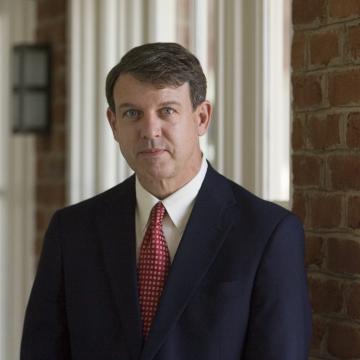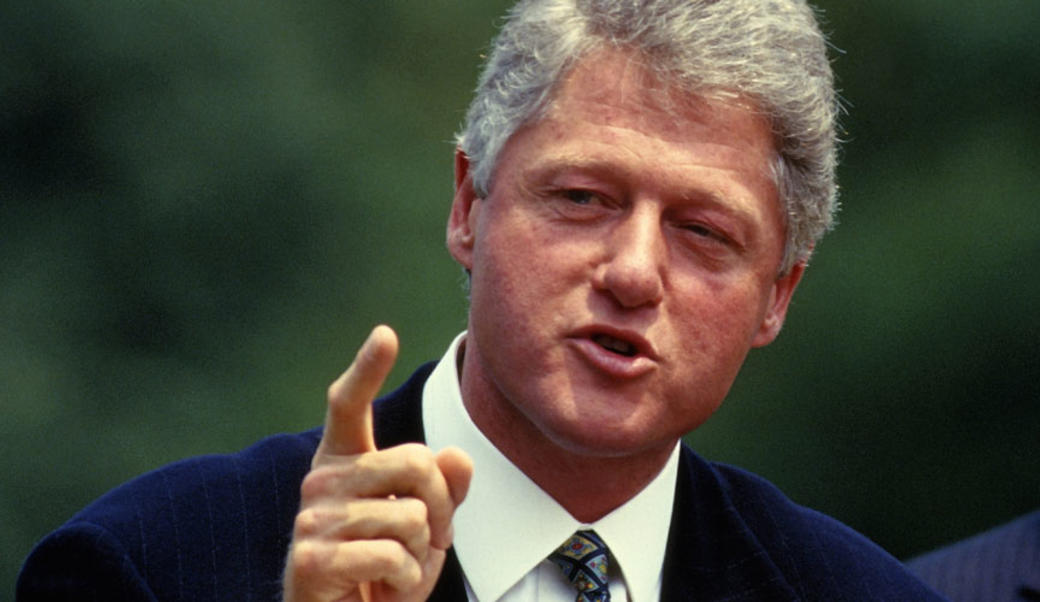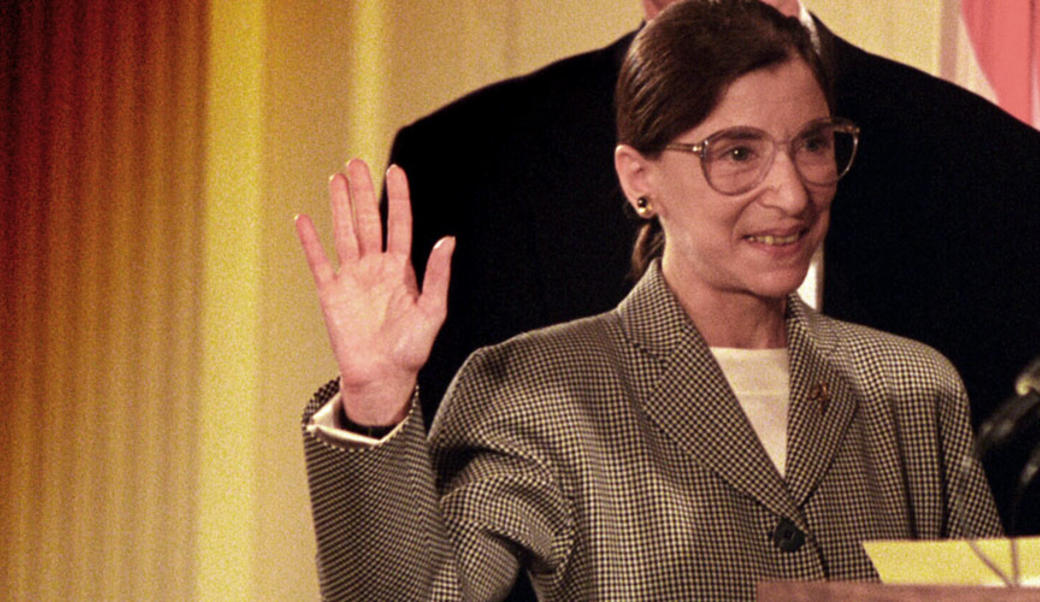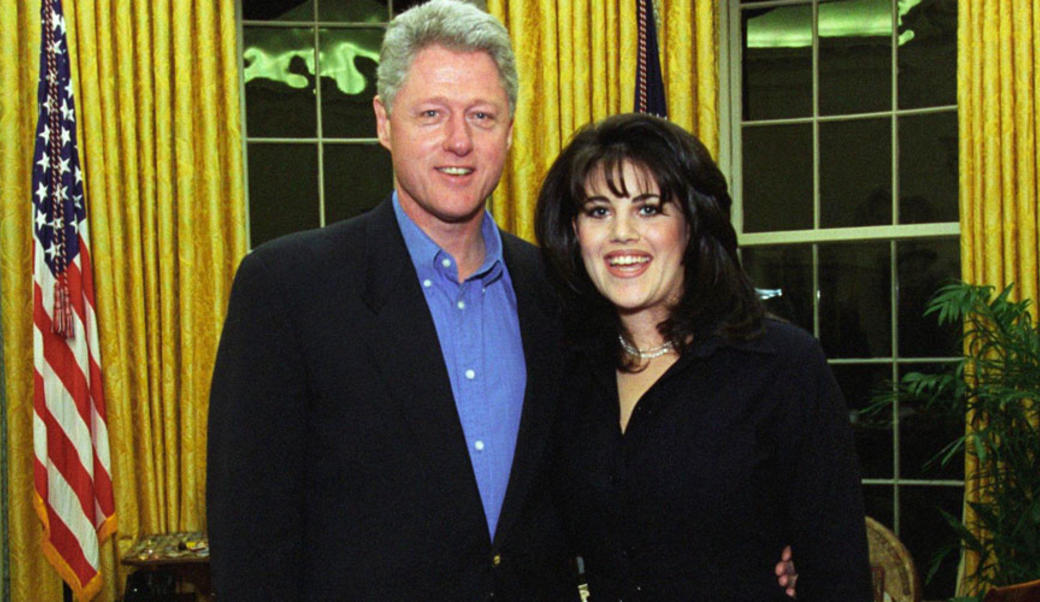Bill Clinton: Domestic Affairs
Bill Clinton began his transition into the presidency promising to focus "like a laser beam" on the economic needs of the nation: unemployment, the runaway deficit, the health care crisis, and welfare reform. On all fronts but one, health care reform, he succeeded significantly but not completely.
Fulfilling Campaign Promises
By the end of his first year, Clinton had battled Congress to secure adoption of an economic package that combined tax increases (which fell mainly on the upper class) and spending cuts (which hurt mainly impoverished Americans). His 1993 economic package passed without a single Republican vote in either chamber of Congress, and despite that party's dire predictions that it would result in economic chaos. This economic policy lowered the deficit from $290 billion in 1992 to $203 billion by 1994. By 1999, surging tax revenues from a booming economy had generated a surplus of $124 billion—a development few would have thought possible in 1992. Surpluses amounting to $1.5 trillion were then projected for the first decade of the 21st century. Equally important were the pace of economic growth and low inflation. Combined with historically low interest and unemployment rates, these factors positioned the American economy as the world's strongest and most robust.
On some other issues, like passage of the North American Free Trade Agreement (NAFTA), which cleared Congress in 1993, Clinton essentially endorsed Republican programs and benefited from Republican support. On others, like welfare reform, the Republican-controlled Congress accepted Clinton's lead in publicizing the issues, but dominated the writing of legislation creating the actual programs. In the summer of 1996, Congress passed a sweeping reform bill, fulfilling Clinton's 1992 campaign promise to "end welfare as we know it." The legislation replaced the long standing Aid to Families with Dependent Children (AFDC) program with a system of block grants to individual states. It also dropped the eligibility of legal immigrants for welfare assistance during the first five years of their residency. Clinton also won an increase in the minimum wage to $5.15 per hour. At the same time, the President blocked Republican attempts to bar public education to children of illegal immigrants.
During the 1992 presidential campaign, Clinton had also vowed to end the exclusion of homosexuals from military service. A federal court ruling just days after Clinton's election moved that controversial topic onto the public agenda, where it was difficult for the President to set it aside until a more convenient time. A political fight ensued with conservative members of Congress and the leadership of the armed forces. Clinton compromised by agreeing to delay a decision on gays in the military for six months. He ultimately proposed a policy of "don't ask, don't tell," meaning that the military services would not ask about the sexual orientation of service personnel and that these personnel, in turn, would not be required to divulge this information. The compromise seemed to satisfy few people. Liberals and gays felt betrayed by the President, and conservatives overrode the administration's executive directive by writing a more restrictive policy into law in a defense authorization bill. But the controversy knocked the administration off balance politically at the very outset of the first term.
Clinton also looked weak and out of his depth when he withdrew the names of two female nominees for attorney general because they had legal problems with hired immigrant household help. The President's image problem took another hit when he retracted the nomination of Lani Guinier, an African-American law professor and old personal friend, to head the Civil Rights Division of the Department of Justice. Guinier's nomination was jeopardized when critics attacked her legal writings about representation as too radical.
Cabinet and Staff Appointments
During his campaign in 1992, Clinton had promised to form a cabinet "that looked like America." Having lost two female candidates to early controversy, Clinton finally settled on Florida prosecutor Janet Reno for attorney general. Clinton went on to name three other women to cabinet positions: Donna E. Shalala, who had been chancellor of the University of Wisconsin at Madison, as secretary of health and human services; Hazel O'Leary, an African-American woman, as secretary of energy; and Madeleine K. Albright as secretary of state (she had previously served as Clinton's ambassador to the United Nations).
The President also put women in several other important posts. His campaign media manager Dee Dee Myers was appointed press secretary and California economist Laura D'Andrea Tyson became chair of the Council of Economic Advisers. Florida environmental official Carol Browner—also Al Gore's one-time legislative assistant—was named to the top slot in the Environmental Protection Agency. Additionally, Dr. Joycelyn Elders, an African-American who was serving as the Arkansas health director, became U.S. surgeon general. And when Supreme Court justice Byron White retired in 1993, Clinton named Ruth Bader Ginsburg as his replacement; Ginsburg was a federal appeals court judge who had taught at Columbia Law School and pioneered the litigation of cases involving sex discrimination.
Clinton also named several African-American males to leading posts in the administration. He tapped Democratic national chairman Ronald H. Brown as secretary of commerce; former Mississippi congressman Mike Espy as secretary of agriculture; Jesse Brown, a disabled Marine veteran, who ran the Disabled American Veterans office in Washington, as secretary of veterans affairs; and Clifton Wharton, Jr., chairman of TIAA-CREF, as deputy secretary of state. Latinos were also appointed in more substantial numbers than in previous administrations, with former San Antonio, Texas, mayor Henry G. Cisneros as secretary of housing and urban development and Federico Pena as secretary of transportation.
Health Care Reform
Along with the political scandals that plagued his presidency, Clinton failed to realize a major goal of his administration: affordable health care insurance for every American. The United States is the only industrialized nation in the world without a universal health care system, and Clinton felt passionately about the fact that 60 million Americans did not have adequate health insurance. In addition, health-care costs had skyrocketed since the 1970s, consuming, according to some estimates, one seventh of the nation's goods and services—a greater proportion than that of any other industrialized country in the world. Winning a national health package would have provided Clinton with a lasting historical legacy, much as Franklin D. Roosevelt had achieved with Social Security. In the minds of some, Clinton's health care program—if realized—would have constituted the most important piece of social legislation in American history.
The consequences of health care reform were enormous. If Clinton could control health-care costs, he could remove a major drag on the economy. From a political standpoint, universal health care would link the middle-class and the working-class to the Democratic Party for at least another generation. Republicans understood the implications of such a victory and were, with rare exceptions, united in their determination to deny Clinton on this issue. Many Americans, while wanting health insurance, worried, too, that national health insurance was socialistic, a step that would deny Americans the right to see a doctor of their choice while placing physicians in the service of a government bureaucracy.
To push through a health-reform bill in his first hundred days in office, Clinton named his wife, Hillary Rodham Clinton, head of a task force to develop the program, and Ira Magaziner as its director. Hillary Clinton, a hard-driving, forceful, and committed feminist with a distinguished legal career, was Clinton's closest political confidant—his true partner in his political career. The President appointed her to head the task force, which would be administered by Magaziner, because he knew that she cared deeply about the issue, and that "if anybody had a chance to do it, she had the best chance." Hillary had led a commission on education reform in Arkansas for her husband—to critical acclaim—and the President wanted her to do the same thing for health care nationally.
The appointment of Hillary was a serious mistake. It immediately placed the First Lady in a position of being a major policy and political power—an appointment that deviated significantly from precedent, allowing critics to attack her as well as the program. Moreover, her unique relationship with the President meant that other advisers reacted to her differently than they would to any other task-force head, not wanting to alienate the President's wife with difficult but well-intentioned criticism. Hillary also blundered in several important ways. Her decision to recruit a task-force network of experts to work in secret on complex issues—such as health-care premiums, managed competition, and health-care alliances—looked too much like policy by cabal and fiat. A federal court forced her to make records publicly available of some of the proceedings, after some in the health-care industry sued for open access. Most importantly, the process largely left Congress out of the picture as the task force drafted the particulars of the plan, thus reducing the plan's chances for legislative success; Clinton had wanted to present to Congress a finished package, which meant that key participants in the congressional lawmaking process were not involved in its drafting. Moreover, there was significant internal disagreement within the administration about the costs of the plan, its scope, and its political marketability.
Republican and Public Backlash
The final product was a massively complicated and sophisticated measure, completely beyond the reach of the average citizen to comprehend. Nearly 1,350 pages long, the proposal had taken much longer to produce than originally imagined. Some critics immediately complained that the President had misstepped in not going to the public with the broad outlines of the plan that then could have been worked through the congressional committee process. Although Clinton's September 1993 speech on national health care effectively dramatized the need for reform, Republican opponents lashed out at the plan's size, incomprehensibility, and threat to small business and individual choice. A consortium of health-insurance companies funded a series of sophisticated, negative TV ads featuring "Harry and Louise," a middle-class couple deeply worried about losing the quality health care they had come to expect as Americans.
The coordinated Republican attack was greatly assisted by the outbreak of the Whitewater investigation and the suicide of White House aid Vincent Foster—a distraction that put the Clinton administration on the defensive. No extreme seemed out of bounds in attacking the President and First Lady. Conservative talk-radio hosts ridiculed the President daily, suggesting that Foster's death might have resulted from his harboring dark White House secrets—or even that someone close to the President had murdered him.
Although Clinton had threatened to veto any health-care proposal that did not include universal coverage, no legislation ever got that far. By summer of 1994, health care reform was doomed; congressional leaders dropped consideration of it in August. Opinion polls revealed public support for the general principles of reforming the health-care system, but the approval number dropped enormously once Clinton's name was attached to such a proposal. The loss of health care reform was a devastating setback. In the minds of many political analysts, it was a botched opportunity of gigantic proportions.
Scandals and Impeachment
Throughout his time in office, Clinton was regularly besieged by political opponents, especially those on the far right-wing of the Republican Party. A combination of such attacks, and the Clintons' own missteps, made the President and First Lady the subjects of numerous special investigations.
Whitewater and Paula Jones
The earliest sustained attacks on Clinton were those that charged him with a cover-up of financial impropriety in his Arkansas investments prior to becoming President. The issue involved a failed savings-and-loan company operated by Clinton business associates James and Susan McDougal, who had engaged in questionable business dealings involving real estate on the Whitewater River in Arkansas. Once credible charges of impropriety were made, Clinton's attorney general, Janet Reno, named a special counsel, Republican Robert B. Fiske, Jr., on her own authority, to investigate. Not long thereafter, President Clinton signed into law a statute reauthorizing the naming of independent counsels. A three-judge federal panel subsequently claimed that Fiske had a conflict of interest because the President's own attorney general had appointed him, and so it removed Fiske and replaced him with Kenneth W. Starr. Starr was a attorney and former federal judge who had also been retained by various conservative clients, including corporations such as tobacco firms that had actively opposed parts of the Clinton agenda.
Searching for evidence of crime and cover-up, Starr began an open-ended inquiry into every corner of Clinton's life, revisiting issues Fiske had considered settled in the President's favor (and ultimately reaching similar conclusions on those mattes as his predecessor.) No stone was left unturned, including an unprecedented subpoena of the First Lady to testify about lost billing records from the Rose law firm (in which she had been a partner in Arkansas) that mysteriously turned up in the residence area of the White House. Personal or business associates of the Clintons, past and present members of the President's political staff and administration, and just about anyone who might have knowledge of their private and public actions were subject to subpoena as witnesses to be questioned. Any criminal actions uncovered in the search for evidence against Clinton were subject to prosecution regardless of their links to Whitewater or to the President. Defenders of the President, and of the institution of the presidency, decried excesses in these investigations as detrimental to justice and to the fair functioning of the political process. Starr defended his actions as essential to getting at the truth of what the Clintons had done on a series of questionable legal and financial transactions.
Although the Clintons generally weathered the storm, they spent much of their time assembling their defense. Beyond the Whitewater affair, the President suffered a major setback on May 27, 1997, when the Supreme Court ruled 9 to 0 in Clinton v. Jones that the sexual harassment suit Paula Jones brought against the President could go forward while he was in office. The Court, reversing the closest precedent Nixon v, Fitzgerald, held that the President could easily defend himself without being overly distracted from his official duties. The Court was proved to be wrong in this assumption.
Lewinsky Affair and Impeachment
In January 1998, news broke that President Clinton had engaged in an affair with a White House intern, Monica Lewinsky. This story was political dynamite, not just because it was a sex scandal, but also because it had dire legal implications. Kenneth Starr's vast investigations into the Whitewater land transaction had stalled, with several prospective witnesses being uncooperative. Starr thought the White House was involved in efforts to buy silence. When a disgruntled White House employee, Linda Tripp, approached Starr's investigators with evidence of the President's hidden relationship with Lewinsky, Starr believed he saw the pattern being repeated once again: Lewinsky was protecting Clinton because she was being bought off with promises of employment. Thus Starr expanded the investigations to include not just the President's financial affairs but also his sexual behavior. Starr's investigators questioned Clinton under oath about his relationship with Lewinsky. This testimony—and subsequent efforts by the White House to deal with Lewinsky-related evidence, which bore some signs of tampering—formed the basis for Starr's subsequent charge of illegal conduct by Clinton and were thus at the core of Clinton's impeachment. Starr was convinced that Clinton had lied in trying to cover up the affair, and that he had instructed others to obstruct justice by lying on his behalf. To many observers, impeachment or resignation seemed to be the only resolution.
The next seven months found the American public consumed by the Lewinsky affair, following every nuance of the investigation by Starr and debating the merits of the case. Nothing like this had so captured the attention of the American public since Watergate and Nixon's resignation from office. Startling revelations came out, including taped interviews in which Lewinsky described details of the affair as well as a dress that contained samples of the President's DNA. On August 17, 1998, following his testimony before a federal grand jury on the matter, Clinton acknowledged in a televised address to the nation his "inappropriate" conduct with Lewinsky and admitted that he had misled the nation and embarrassed his family. But he did not admit to having lied, having instructed anyone else to lie, or orchestrating a cover-up involving anyone else.
Starr then sent his report to the House of Representatives alleging that there were grounds for impeaching Clinton for lying under oath, obstruction of justice, abuse of powers, and other offenses. After a vitriolic series of televised House hearings and the release of thousands of documents—many in graphic detail—the House Judiciary Committee, on a strictly partisan vote, recommended that an impeachment inquiry commence. The House adopted two articles of impeachment, charging the President with perjury in his grand jury testimony and obstructing justice in his dealings with various potential witnesses.
The Senate, charged under the Constitution with judging the evidence, opened its trial in mid-January 1999. It became immediately clear that the Senate would not produce a two-thirds majority vote to convict Clinton and remove him from office. Those voting against impeachment argued that the President's actions constituted "low" and tawdry actions involving private matters, not "high crimes and misdemeanors" amounting to offenses against the state. Those voting against Clinton argued that even in private matters, a President who commits perjury and obstructs justice is subverting the rule of law, and that subversion becomes a "high crime." Clinton was acquitted on both counts on February 12, 1999. On the first, 45 Republican senators voted to convict while 45 Democrats and 10 Republicans voted for acquittal. On the second article of obstruction of justice, 50 Republicans voted for conviction while 45 Democrats and 5 Republicans voted for acquittal. Thus, the second President to have been impeached in U.S. history (Andrew Johnson was the first) remained in office, acquitted and with two years left in his second term.
Impeachment Fallout
In the process of pursuing an impeachment of the President, the Republicans had seriously overplayed their hand. An indication of what lay ahead came when the party actually lost five seats in the House while gaining no Senate seats in the November 1998 elections conducted just prior to the impeachment vote. Traditionally, the opposition party registers significant gains in the off-year elections of a President's second term, and so the Republican loss was virtually unprecedented.
As the impeachment process unfolded, Clinton's ratings in public opinion polls were at an all-time high, hovering at close to 70 percent. Most Americans gave Clinton low marks for character and honesty. But, they gave him high marks for performance and wanted him censured and condemned for his conduct, but not impeached and removed. Many viewed key Republican attackers as mean-spirited extremists willing to use a personal scandal for partisan goals. In the end, voters were happy with Clinton's handling of the White House, the economy, and most matters of public life. Hillary Clinton's public opinion poll ratings actually exceeded the President's, in large measure because of her dignified demeanor during those trying personal times, thus lifting her popularity to among the highest ever for a First Lady.
The Republican Revolution
By 1998, the Republican offensive that captured both houses of Congress in 1994 had run out of steam. Not only did the Republicans lose the presidential election of 1996 (see previous discussion) but they also lost public support by overplaying their hands in the impeachment of a popular President during times of prosperity. As a result, the nation settled for compromise or deadlock for the last two years of the Clinton presidency. During this period, the administration decided that it could best achieve some of its policy goals through executive order. For example, the President signed several proclamations in 2000 creating national monuments out of vast expanses of the American West. Of course, as they were to discover in subsequent years, anything done by executive order can also be undone that same way, if a succeeding President is so inclined.
In one remaining area of executive authority, the President sparked a final controversy. In the dwindling hours of his term, Clinton issued 140 presidential pardons, several of which drew heated criticism not just from the President's usual opponents, but also from some supporters. The most controversial was the pardon of international fugitive Marc Rich, whose ex-wife was a prominent Democratic fundraiser. Few questioned the President's authority to exercise this constitutional power, but many believed that the authority had not been wisely used in several cases. Clinton thus left office dogged by charges of scandal that had been a staple of his time in the White House.




